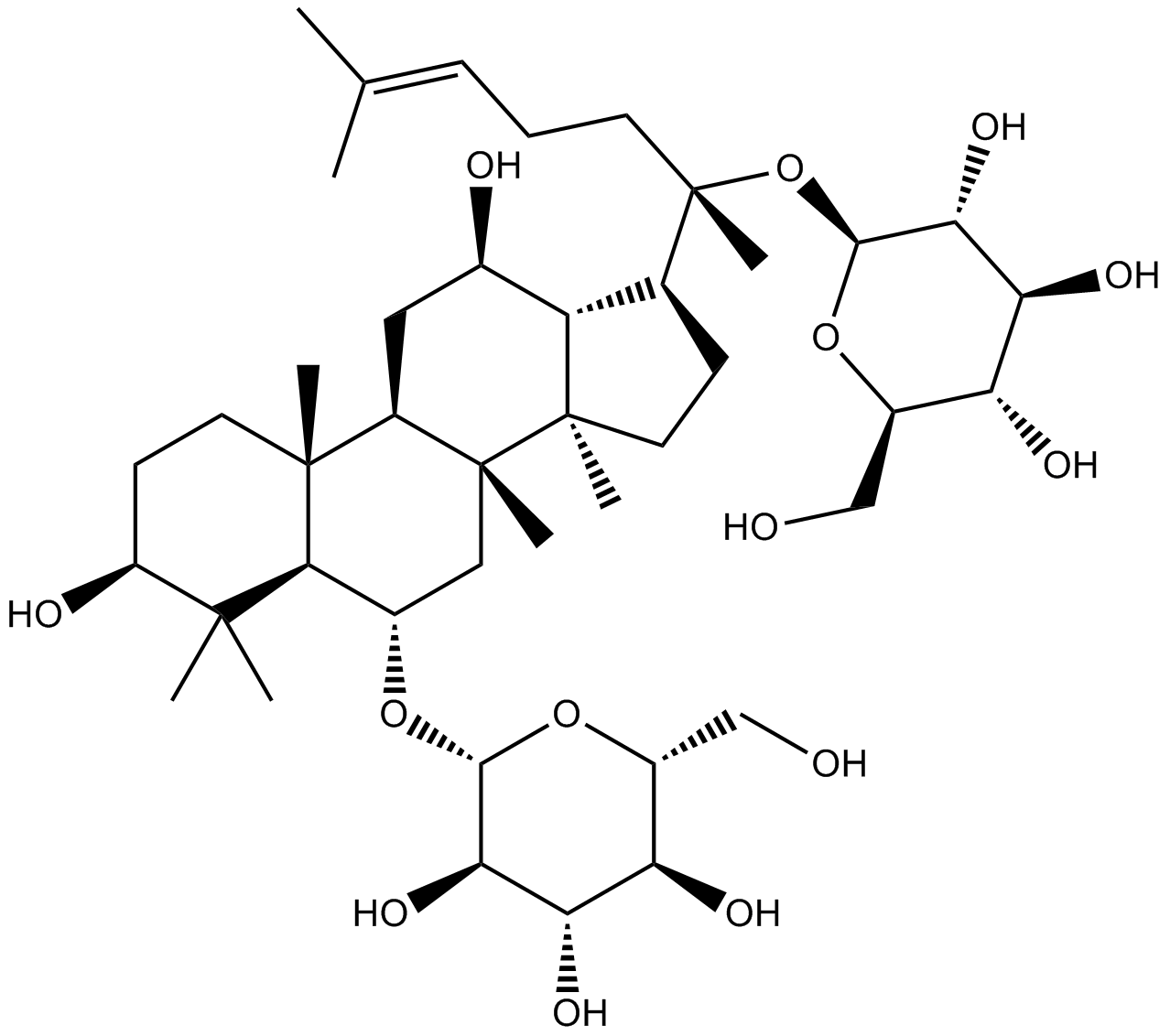Ginsenoside Rg1 (Synonyms: Ginsenoside A2, Panaxoside A, Panaxoside Rg1, Sanchinoside C1, Sanchinoside Rg1) |
| Catalog No.GN10544 |
Ginsenoside Rg1 is one of the main active ingredients of ginseng and a steroidal glycoside with various biological activities. Ginsenoside Rg1 reduces brain Aβ levels and reduces NF-κB nuclear translocation.
Products are for research use only. Not for human use. We do not sell to patients.

Cas No.: 22427-39-0
Sample solution is provided at 25 µL, 10mM.
Ginsenoside Rg1, one of the main active components found in Panax ginseng, is a class of natural products known as steroid glycosides with a wide range of biological activities. Ginsenoside Rg1 has attracted significant attention due to its various pharmacological effects, including the promotion of hippocampal neurogenesis, improvement of neural plasticity, enhancement of learning and memory, anti-aging and anti-fatigue effects, as well as immunoregulatory and anti-tumor activities. Treatment with G-Rg1 has also been shown to significantly reduce the expression of TNF-α, IL-1β, and IL-6 in ischemia-reperfusion animal and cell models[1]. Ginsenoside Rg1 has been demonstrated to have significant neuroprotective effects, reduce brain levels of Aβ, and decrease NF-κB nuclear translocation, making it a potential therapeutic agent for neurodegenerative diseases such as Alzheimer's and Parkinson's diseases[4].
In vitro, ginsenoside Rg1 (5 μmol/L) significantly promoted the proliferation and differentiation of human dental pulp cells (hDPCs). Compared with the control group, the induced group, the ginsenoside Rg1 group, and the combination of both showed increased ALP activity and expressions of DSPP and DMP1 genes[1]. Another study indicated that Rg1 significantly reduced the levels of TNF-α and IL-6 in inflamed joints of AIA rats and LPS-stimulated RAW 264.7 cells, increased PPAR-γ protein expression, and inhibited the phosphorylation of IκBα and the nuclear translocation of NF-κB[2].
In vivo, intraperitoneal injection of Rg1 (5, 10, and 20 mg/kg) in AIA rats for 14 consecutive days showed therapeutic effects on arthritis, significantly alleviating joint swelling and damage[2]. Moreover, treatment with ginsenoside Rg1 and Rg2 (30 mg/kg; 1 month) effectively improved the cognitive function of APP/PS1 mice, observed gradual improvement in brain pathological abnormalities, and effectively reduced the accumulation of Aβ deposits[3].
References:
[1] Zhang L, et al. Ginsenoside Rg1 attenuates adjuvant-induced arthritis in rats via modulation of PPAR-γ/NF-κB signal pathway. Oncotarget. 2017 Jul 24;8(33):55384-55393.
[2] Wang P, et al. Effect of ginsenoside Rg1 on proliferation and differentiation of human dental pulp cells in vitro. Aust Dent J. 2012 Jun;57(2):157-65.
[3] Li N, et al. A UPLC/MS-based metabolomics investigation of the protective effect of ginsenosides Rg1 and Rg2 in mice with Alzheimer's disease. J Ginseng Res. 2016 Jan;40(1):9-17.
[4] Xie W , Zhou P , Sun Y ,et al. Protective Effects and Target Network Analysis of Ginsenoside Rg1 in Cerebral Ischemia and Reperfusion Injury: A Comprehensive Overview of Experimental Studies[J].Cells, 2018, 7(12).
Average Rating: 5 (Based on Reviews and 30 reference(s) in Google Scholar.)
GLPBIO products are for RESEARCH USE ONLY. Please make sure your review or question is research based.
Required fields are marked with *




















